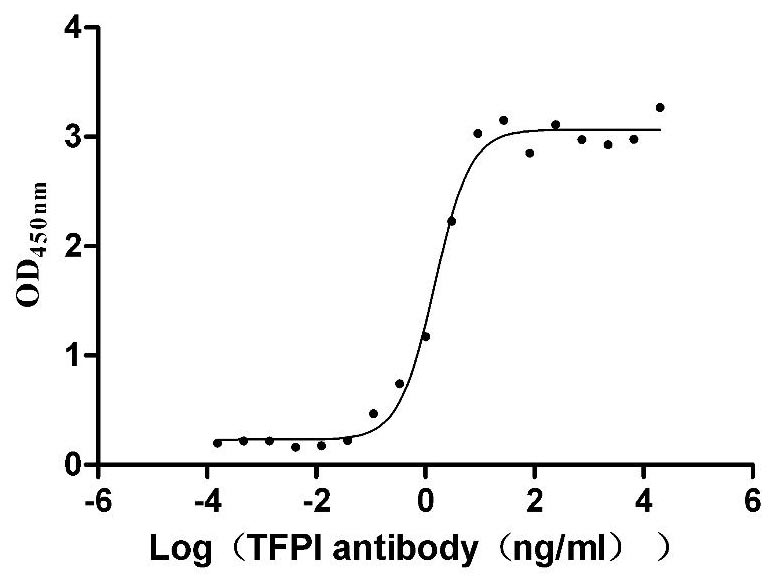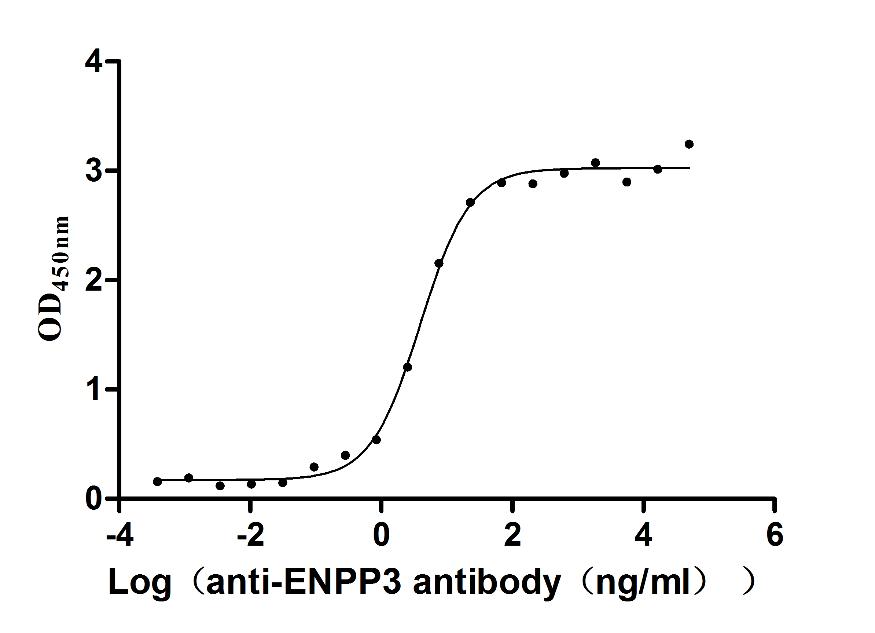Recombinant Mouse Histidine decarboxylase (Hdc)
-
中文名称:小鼠Hdc重组蛋白
-
货号:CSB-YP010246MO
-
规格:
-
来源:Yeast
-
其他:
-
中文名称:小鼠Hdc重组蛋白
-
货号:CSB-EP010246MO
-
规格:
-
来源:E.coli
-
其他:
-
中文名称:小鼠Hdc重组蛋白
-
货号:CSB-EP010246MO-B
-
规格:
-
来源:E.coli
-
共轭:Avi-tag Biotinylated
E. coli biotin ligase (BirA) is highly specific in covalently attaching biotin to the 15 amino acid AviTag peptide. This recombinant protein was biotinylated in vivo by AviTag-BirA technology, which method is BriA catalyzes amide linkage between the biotin and the specific lysine of the AviTag.
-
其他:
-
中文名称:小鼠Hdc重组蛋白
-
货号:CSB-BP010246MO
-
规格:
-
来源:Baculovirus
-
其他:
-
中文名称:小鼠Hdc重组蛋白
-
货号:CSB-MP010246MO
-
规格:
-
来源:Mammalian cell
-
其他:
产品详情
-
纯度:>85% (SDS-PAGE)
-
基因名:Hdc
-
Uniprot No.:
-
别名:HdcHistidine decarboxylase; HDC; EC 4.1.1.22
-
种属:Mus musculus (Mouse)
-
蛋白长度:Full length protein
-
表达区域:1-662
-
氨基酸序列MMEPCEYREY REYYRARGKE MVDYISQYLS TVRERQVTPN VQPGYLRAQL PASAPEEPDS WDSIFGDIER VIMPGVVHWQ SPHMHAYYPA LTSWPSLLGD MLADAINCLG FTWASSPACT ELEMNIMDWL AKMLGLPEYF LHHHPSSRGG GVLQSTVSES TLIALLAARK NKILAMKACE PDANESSLNA RLVAYTSDQA HSSVEKAGLI SLVKIRFLPV DDNFSLRGEA LQKAIEEDKQ QGLVPVFVCA TLGTTGVCAF DRLSELGPIC ASEGLWLHVD AAYAGTAFLC PELRGFLEGI EYADSFTFNP SKWMMVHFDC TGFWVKDKYK LQQTFSVNPI YLRHANSGAA TDFMHWQIPL SRRFRSIKLW FVIRSFGVKN LQAHVRHGTE MAKYFESLVR SDPSFEIPAK RHLGLVVFRL KGPNCLTESV LKEIAKAGQL FLIPATIQDK LIIRFTVTSQ FTTKEDILRD WHLIQEAANL VLSQHCTSQP SPRAKNVIPP PPGTRGLSLE SVSEGGDDPA QARKIIKQPG ASLARREGGS DLETMPDPFD DCFSEEAPNT TKHKLSSFLF SYLSVQNRRK TTRSLSCNSV PMSAQKSLPA DASLKNGGSF RARIFSGFPE QMMMMKKGAF KKLIKFYSVP SFPECSSQCA RQLPCCPLEA MV
-
蛋白标签:Tag type will be determined during the manufacturing process.
The tag type will be determined during production process. If you have specified tag type, please tell us and we will develop the specified tag preferentially. -
产品提供形式:Lyophilized powder
Note: We will preferentially ship the format that we have in stock, however, if you have any special requirement for the format, please remark your requirement when placing the order, we will prepare according to your demand. -
复溶:We recommend that this vial be briefly centrifuged prior to opening to bring the contents to the bottom. Please reconstitute protein in deionized sterile water to a concentration of 0.1-1.0 mg/mL.We recommend to add 5-50% of glycerol (final concentration) and aliquot for long-term storage at -20℃/-80℃. Our default final concentration of glycerol is 50%. Customers could use it as reference.
-
储存条件:Store at -20°C/-80°C upon receipt, aliquoting is necessary for mutiple use. Avoid repeated freeze-thaw cycles.
-
保质期:The shelf life is related to many factors, storage state, buffer ingredients, storage temperature and the stability of the protein itself.
Generally, the shelf life of liquid form is 6 months at -20°C/-80°C. The shelf life of lyophilized form is 12 months at -20°C/-80°C. -
货期:Delivery time may differ from different purchasing way or location, please kindly consult your local distributors for specific delivery time.Note: All of our proteins are default shipped with normal blue ice packs, if you request to ship with dry ice, please communicate with us in advance and extra fees will be charged.
-
注意事项:Repeated freezing and thawing is not recommended. Store working aliquots at 4°C for up to one week.
-
Datasheet :Please contact us to get it.
靶点详情
-
功能:Catalyzes the biosynthesis of histamine from histidine.
-
基因功能参考文献:
- The results of this study indicated that Hdc deficiency in mice does not disturb the development of striatal and cortical interneurons and does not lead to the morphological and cytological phenotypes characterized by humans with Guilles de la Tourette syndrome. PMID: 28681514
- Genetic abnormalities in histaminergic signaling may produce a vulnerability to inflammatory challenge, setting the state for pathogenically dysregulated neuroimmune responses. PMID: 27381299
- The H3 receptor is upregulated in the striatum in the Hdc KO mouse model of tic disorders. PMID: 28117842
- Lack of endogenous histamine in NOD HDC(-/-) mice decreased the incidence of diabetes in relation to their wild-type counterpart. PMID: 26090474
- the structure and function of the retina in mice that lacked expression of the rate limiting enzyme in the formation of histamine, histidine decarboxylase (Hdc-/- mouse), were investigated. PMID: 25545149
- SDS induces itch through increased production of epidermal histamine, which results from an increase in the gene expression and post-translation processing of L-histidine decarboxylase. PMID: 24603881
- HDC, whose expression is remarkably downregulated during the first few days after birth in dermal cells of mice, plays essential roles in the hair-inducing ability of newborn mouse dermal cells PMID: 22726259
- An increased expression of H3 receptors in HDC KO mice without any changes in the spontaneous firing of "histaminergic" neurons without histamine and their responses to the H3 receptor agonist (R)-alpha-methylhistamine. PMID: 21710252
- Histidine decarboxylase was found at comparably high levels in mouse striatum. PMID: 21440039
- There was no difference in the levels of vascular endothelial growth factor between HDC-/- or wild-type mice, either in the lung or in bronchoalveolar-lavage cells. PMID: 20715981
- The absence of histamine adversely affects splenic hematopoiesis via direct and indirect mechanisms PMID: 19921486
- HDC-/- mice showed reduced severity of K/BxN serum-induced arthritis. PMID: 19762454
- Targeted deletion of this gene in mice increases bone formation and protects against ovariectomy-induced bone loss. PMID: 12716972
- in 12 day old embryonic stem cells histidine decarboxylase was confined to peripheral cells and small clusters of cells, inner cells were usually negative for it PMID: 12755409
- Metabolic phenotype of mice lacking histamine due to targeted disruption of histidine decarboxylase. Characterized by visceral adiposity, increased of brown adipose tissue, impaired glucose tolerance, hyperinsulinemia, and hyperleptinemia. PMID: 12960041
- histidine decarboxylase has a role in CYP2E1 and CYP3A activity, but not in CYP1A and CYP2B activity PMID: 14642533
- We hypothesize that during the chronic phase of infection elevated HDC levels, possibly of mast cell origin, are associated with Th2-dominated responses and serious disease development. PMID: 15021979
- In HDC-deficient mice, development of amygdaloid kindling is significantly accelerated and duration of afterdischarge and generalized seizure is prolonged, compared to wild-type mice. PMID: 15030492
- self-antigen binding repertoires of natural autoantibodies in histidine decarboxylase knock-out mice, unable to synthesize histamine PMID: 15120753
- Chronic histamine deficiency in histamine decarboxylase knockout mice affects frontal cortex (FC) and neostriatal acetylcholine contents and increases FC serotonin turnover under stimulated post-behavioral teting conditions. PMID: 15305873
- activity in hypertrophic and hyperplastic kidney PMID: 15928837
- compared to female control mice, Hdc(-/-) female mice showed hypoactivity, increased measures of anxiety, impairments in water-maze performance, but enhanced passive avoidance memory retention PMID: 16310870
- histamine in anxiety and cognition and underline the importance of considering age and potential effects on measures of anxiety in the interpretation of the role of histaminergic neurotransmission in cognitive function. PMID: 16412995
- HDC expression and histamine production are increased in the superficial kidney cortex zone during pregnancy PMID: 16760908
- In histamine-deficient histidine decarboxylase knockout mice fed an high fat diet for 8 weeks body weight, epididymal adipose tissue size, and plasma leptin concentration had increased significantly. PMID: 16926531
- Sp1 is one of the transcription factors that regulate the LPS-induced expression of HDC in RAW 264 cells PMID: 16949047
- amount of serotonin was significantly higher in the histidine decarboxylase gene knock-out animals PMID: 17431746
- HDC-KO mice exhibited improved contextual fear from 1 day after training and this lasted for at least 14 days when compared with the wild-type (WT) controls. PMID: 17534971
- This study provide evidence that formalin-evoked painful stimulus elicits rapid alterations in the activity of neuroglial elements of histidine decarboxylase-deficient mice that are involved in the communication between brain and csf space. PMID: 17544458
- Knock-out of the histidine decarboxylase gene causes a general endocrine imbalance in the hormones which are related to histamine, namely ACTH, triiodothyronine and endorphin inside the immune cells. PMID: 18026700
- Histidine-decarboxylase (a histamine synthesizing enzyme) knock-out mice displayed sleep fragmentation and increased paradoxical sleep compared to wild-type mice. PMID: 19923277
显示更多
收起更多
-
蛋白家族:Group II decarboxylase family
-
数据库链接:
KEGG: mmu:15186
STRING: 10090.ENSMUSP00000028838
UniGene: Mm.18603
Most popular with customers
-
Recombinant Human Tissue factor pathway inhibitor (TFPI), partial (Active)
Express system: Mammalian cell
Species: Homo sapiens (Human)
-
Recombinant Human Angiopoietin-2 (ANGPT2) (Active)
Express system: Mammalian cell
Species: Homo sapiens (Human)
-
Express system: Mammalian cell
Species: Macaca fascicularis (Crab-eating macaque) (Cynomolgus monkey)
-
Recombinant Human Claudin-9 (CLDN9)-VLPs (Active)
Express system: Mammalian cell
Species: Homo sapiens (Human)
-
Recombinant Human Claudin-6 (CLDN6)-VLPs, Fluorescent (Active)
Express system: Mammalian cell
Species: Homo sapiens (Human)
-
Recombinant Human Claudin-3 (CLDN3)-VLPs (Active)
Express system: Mammalian cell
Species: Homo sapiens (Human)



-AC1.jpg)


f4-AC1.jpg)











